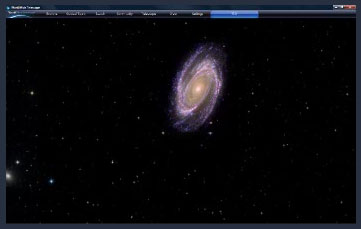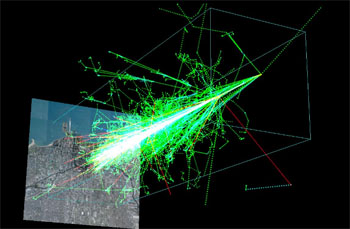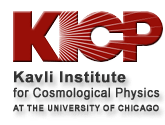|
Important Dates
|
- March 15, 2010 - Registration deadline
- April 1, 2010 - Registration form completed and $50 registration fee paid (for accepted applications)
- April 28 - 30, 2010 - "Exploring the Universe Bit by Bit" Workshop
|
|
|
 |
 | SOFTWARE |
|
 |
 WWT provides has several visualization modes including all-sky imagery, panoramas, planets, and 3d Universe mode. The all-sky mode provides pole-to-pole coverage of the celestial sphere with hundreds of all sky surveys, and millions of study images. The panorama mode allows viewing immersive photographic panoramas from missions to other planets, or even back on earth. The 3d universe mode has an astrometrically correct view of the universe where you can fly from 1 meter resolution on earth or the planets out thru the Solar System, the Milky Way, out to the large scale structure of the universe. Integrating this all together is a tour authoring environment that allows any user to create an immersive tour of any and all of the WWT modes, along with music, voice-over and user provided data. WWT provides has several visualization modes including all-sky imagery, panoramas, planets, and 3d Universe mode. The all-sky mode provides pole-to-pole coverage of the celestial sphere with hundreds of all sky surveys, and millions of study images. The panorama mode allows viewing immersive photographic panoramas from missions to other planets, or even back on earth. The 3d universe mode has an astrometrically correct view of the universe where you can fly from 1 meter resolution on earth or the planets out thru the Solar System, the Milky Way, out to the large scale structure of the universe. Integrating this all together is a tour authoring environment that allows any user to create an immersive tour of any and all of the WWT modes, along with music, voice-over and user provided data.
WorldWide Telescope, created with Microsoft's high-performance Visual Experience Engine(TM), enables seamless panning and zooming across the night sky, blending terabytes of images, data, and stories from multiple sources over the Internet into a media-rich, immersive experience. WWT is a scalable system that can run in environments from inside a web browser, to 3d accelerated desktop, to full multi-channel dome systems. WWT is also the most extensive way to user real astronomy data in the rich environment supporting native astronomy data standards like VO Table, AVM, SAMP and FITS.
Software Developers/Instructors
|
 |
 |
|  |
 |
 Partiview was created by the Virtual Director Group at the National Center for Supercomputing Applications (NCSA) at the University of Illinois, Urbana-Champaign. It is the child of a larger program called Virtual Director which was developed to create and edit flight paths through data sets in the CAVE virtual reality environment. These recorded flight paths are useful when making digital movies for educational programs like NOVA, IMAX films, and even the Space Shows at the Hayden Planetarium. Partiview was created by the Virtual Director Group at the National Center for Supercomputing Applications (NCSA) at the University of Illinois, Urbana-Champaign. It is the child of a larger program called Virtual Director which was developed to create and edit flight paths through data sets in the CAVE virtual reality environment. These recorded flight paths are useful when making digital movies for educational programs like NOVA, IMAX films, and even the Space Shows at the Hayden Planetarium.
Partiview possesses many of the same features as Virtual Director, allowing one to view and explore data sets on your desktop or laptop. It cannot record flight paths, though it can play them. You can learn more about Partiview and how to visualize your own data in this manual. In addition, log on to Hayden Planetarium to download the latest version of Partiview and accompanying data from Hayden Planetarium's Digital Universe.
It is an industrial strength, interactive, mono- or stereoscopic viewer for 4-dimensional datasets. It is written in C++/ OpenGL and has been compiled to run on Linux, Windows, OS X, and Irix.
Software Developers/Instructors
|
 |
 |
|  |
|


